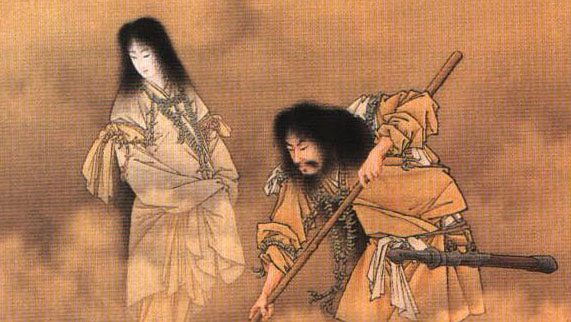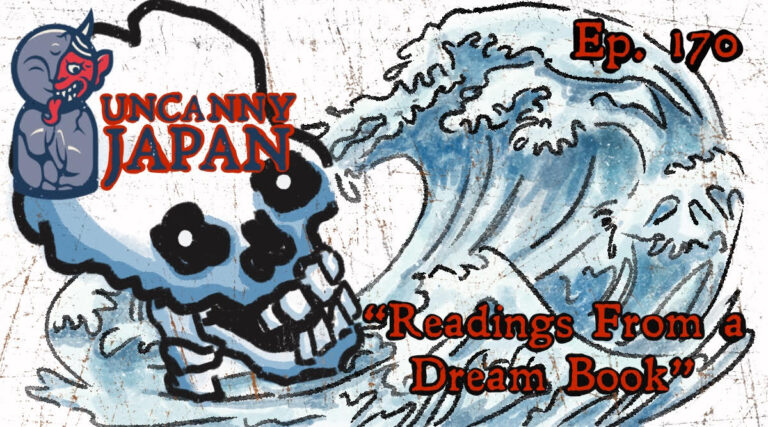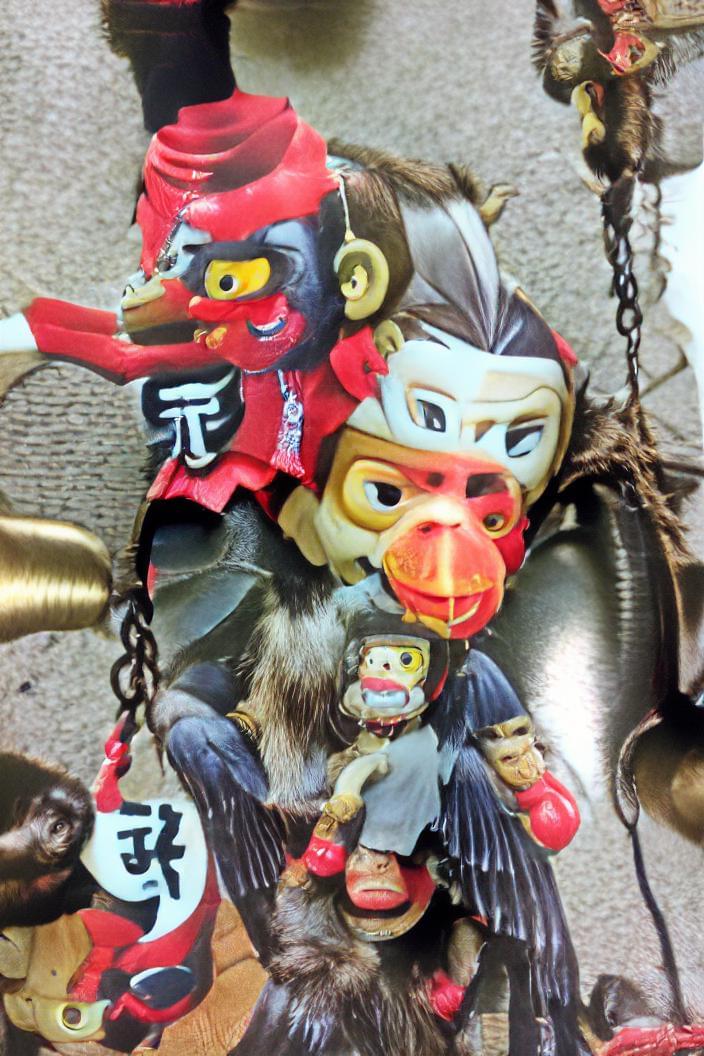Hey, hey. This is Thersa Matsuura, author of the Book of Japanese Folklore and the coming this fall Yōkai Oracle Deck, and I’m here to share with you all those hidden, fascinating, and sometimes frightening corners of Old Japan.
Join me as I explore strange superstitions, curious creatures, and cultural enigmas, right here on Uncanny Japan.
Deep Dive into Myth Tales: Introducing Susanoo
It’s time for another deep dive into myth tales. Number two, to be precise. The first one was episode 132, an origin story that ends with dragons, where I talked about the weird relationship between Izanagi and Izanami, and all the delightful and delightfully weird gods and goddesses and creatures and islands that they created. Logically, next should be Amaterasu, the sun goddess, and the most important deity in the pantheon for Japanese. I’ll get to her in a bit. But right now, I’m kind of intrigued with her brother, Susanoo, the god of storms and sea. He’s an absolute nutter, and I love him.
The Birth of Susanoo from Izanagi’s Purification
Mukashi, mukashi, long, long ago. You’ll remember because you’ve already listened to the origin story, episode 132. Izanagi visited his dead wife/sister in Yomi-no-kuni, land of the dead, or the underworld. Long story short, he snuck a look at her as a rotting corpse when he promised he wouldn’t, and he incurred her wrath, which included a whole horde of nasty demons and oni springing from various parts of her body and chasing after a quickly fleeing Izanagi. He managed to escape, in some versions of the story, by tossing peaches at the monster army. Izanagi was then able to roll a boulder in front of the entrance or exit of the land of the dead, sealing the love of his life and the mob of fiends inside.
Izanagi is feeling pretty gross after this encounter, as you can imagine, so he stops by a river to purify himself. It’s from this little bath that some other gods are born, most importantly, the three precious children. And by “born,” I mean while washing his face, Amaterasu, the sun goddess, springs from his left eye, Tsukuyomi, the moon god, leaps from his right eye, and today’s subject, Susanoo, god of storms and sea, emerges magnificently from his nose. Susanoo right out the gate is a bit of a problem. Keep in mind all three gods aren’t in baby form, they’re full-on adults. But even so, Susanoo is bawling like a little brat, saying he misses his mom and he wants to go see her, like he hasn’t even met his mom. Anyway, he’s crying and howling nonstop, so hard, and I quote, “until his beard, eight hands long, extended down over his chest.” And all that caterwauling caused the mountains to wither and the rivers to dry up.
Susanoo’s Banishment and Journey to Ne-no-kuni
Remember, his dad, Izanagi, is dealing with a lot right now. He’s heartbroken at the loss of his soulmate/wife/sister and has just escaped death by numerous bloodthirsty beasts and had to strip naked and bathe in a river because he was so funky after the encounter. And now this. So he goes and he does what any other new dad would do. He banishes Susanoo from the high plane of heaven down to Ne-no-kuni, root country, or the land of the roots. Some say it’s the same as the underworld, Yomi-no-kuni, but others insist there are some key differences. For one, in Yomi-no-kuni, there is almost no escaping. It’s all about the dead, or the undead, living in the world of the dead. That makes sense. Ne-no-kuni, on the other hand, while it attracts the deceased, is more of a dark place of chaos, monsters, and transformation. It’s also said to be deep in the ocean or beyond the sea. Later, Susanoo will be known as the ruler of Ne-no-kuni, where Izanami, his mom, lords over Yomi-no-kuni, the underworld. So I think they’re different.
So poor, sensitive, I believe misunderstood Susanoo is ordered to go to this scary place. But before he leaves, he says he needs to visit his dear older sister, Amaterasu, to say goodbye. Screw you, Tsukuyomi, moon god, I guess. There really isn’t a whole lot about the moon god, unfortunately. Missed opportunity there.
The Violent Confrontation with Amaterasu
There are several versions of how things went down, but basically, mountains and rivers all over the land shook violently as Susanoo showed up at the sun goddess’s palace. Amaterasu, understandably suspicious of her impulsive brother’s intentions and thinking that maybe he wants to steal her land, dresses up in male clothing and armor. She straps a thousand arrow quiver on her back and a 500 arrow quiver on her chest, stomps the ground, lets out a war cry, and goes out to meet him. Susanoo explains the situation, that he’s been banished and he just wants to say goodbye. He also suggests they swear an oath and make some more gods while they’re at it. A kind of competition. Again, several variations of what happened, but basically, one thing leads to another and Amaterasu, in a very badass move, takes his ten-span sword, breaks it into three pieces, chews each part up, and spits out three new goddesses. Susanoo, in return, snatches up her bracelets and hair decorations, masticates those kama-shaped magatama beads, and then spits out five male deities.
So who won? Amaterasu says since he used her magatama to create the five gods and five is more than three, she won. Susanoo thinks differently. In the end, Susanoo just outright declares that he won the challenge and then proceeds to lose his ever-loving mind. He goes on what’s called a victory rampage. Absolutely unhinged. For days, he goes around destroying everything. He breaks holy bridges, tears up holy rice fields, and smashes parts of the holy palace. He even goes as far as to defecate on Amaterasu’s throne. This is disgusting. I love it. But this whole time, the sun goddess is remaining calm, enduring all this, until he takes a holy horse, flays it alive, punches a hole in the roof of the weaving hall, and tosses the poor animal down. One of Amaterasu’s maidens is so surprised that she runs, bumps her private parts into a weaving shuttle, and dies right then and there. That’s the last straw. Amaterasu marches off and hides herself in the heavenly rock cave and seals it shut. Remember, she’s the sun goddess. So this throws all of heaven and all of earth into darkness.
Now I’ll leave you there in the literal and figurative dark about how that problem got solved, because that’s more of an Amaterasu story, not a Susanoo story. As a teaser, just know that some ingenuity and a risqué dance later, and light is restored onto the world and into heaven again.
Descent to Earth and the Yamata-no-Orochi Encounter
So next we find Susanoo leaving the high plane of heaven and descending to Ashihara-no-Nakatsukuni, central land of reed plains. Imagine an uncivilized, chaotic place of rustling reeds, inhabited by wild gods. Yes, it’s earth, or more precisely, it’s Japan. While wandering around, Susanoo noticed a single chopstick floating down a river, and he surmised there must be a village nearby. He traveled upstream, where he met an elderly couple and a young girl, all weeping piteously. When asked what’s up, the couple told him about how seven of their eight daughters had all been eaten up, one a year, by a nasty, vicious, voracious, eight-headed and eight-tailed serpent or dragon called the Yamata-no-Orochi, and how it was time for their last daughter, Kushinada-hime, to be devoured.
Susanoo asked, “What exactly does this Yamata-no-Orochi look like?” And the description given is just wonderful. Its eyes are like red cherries, and it has eight heads and eight tails. Covered in moss, cypress, and cedar, it spans eight valleys and eight peaks, and when you look at its belly, you see blood oozing out everywhere. Nice. So Susanoo does what any old-timey hero would do. He says, “I’ll slay that serpent dragon with the eight heads and the eight tails, if you let me marry your daughter.” And the father says what any old-timey father would say in folklore of yore. “Sure, here you go.”
The Heroic Battle and Discovery of Kusanagi
So Susanoo promptly turns Kushinada-hime into a comb. Yes, you heard that correctly. He turns her into a comb and puts her in his long locks. “To keep her safe,” he says. Then he instructs the mother and father to brew up something he calls “eightfold brewed sake,” called “yashiori-no-sake.” Eightfold meaning it was extremely potent. Think the ever-clear of nihonshu. Then, after having done that, they were told to build a fence with eight gates and place a vat of that sake at each gate. Next, all they had to do was wait.
Sure enough, the enormous Yamata-no-Orochi comes slithering along and smells this magical sake. It sticks its eight heads through each of the eight gates, and it starts drinking until it’s drunk and passes out.
Now is Susanoo’s time to shine. He takes out his Totsuka-no-Tsurugi sword and starts hacking and hacking and hacking. He cuts the serpent into hundreds of pieces. It’s a gore fest. The river and land is running red with its blood. It’s dead already, but Susanoo keeps going, moving through the tail. Then, twang! His mighty sword hits something, and it snaps in half. Some tales say it was just nicked. What the? He digs around in the dead dragon body and discovers another sword, one more powerful than his, up until then, favorite weapon. This was called the Ame-no-Murakumo-no-Tsurugi, Sword of Gathering Clouds in Heaven, but would later be renamed the Kusanagi-no-Tsurugi, or Grass-Cutting Sword. There’s a nice story behind that, too. I’ll get to that a little later in a different episode.
Just know that this sword went on to become one of the Three Sacred Treasures, or Sanshu no Jingi, or Three Imperial Regalia of Japan. The other two are the magatama bead, a stone or jewel shaped like a kama or half a yin and yang symbol, and a mirror, all still in existence today. Probably. Maybe. Again, that’s another story for another episode.
Marriage, Family, and the Trials of Ōnamuji
So after this epic battle, or, well, more like a slaughtering, the Yamata-no-Orochi didn’t put up much of a fight, Susanoo appointed his new father-in-law the headman of his new dwelling. He and Kushinada-hime had one son. Then he married the daughter of the mountains and had two more children. Susanoo was busy. There were at least thirteen other gods and goddesses born to him. These were a mixture of created in some magical way, like chewing magatama beads, or with a mother who isn’t on record. Finally, after so many years living there, he decided to move on to Ne-no-kuni, the Land of Roots. Remember that? Now I suggest you don’t get any ideas about trying to date or marry any one of his daughters. Or if you do, you’re going to have to be made of some pretty tough stuff.
There’s a tale of a man named Ōnamuji-no-kami, who had some really disturbed brothers who would do things like say, “Hey, Ōnamuji, catch a red wild boar.” And then they’d heat up a large boulder until it was glowing red and roll it down a mountain toward him. The naive Ōnamuji would grab it and promptly get burned to death. His mother steps in, goes to heaven, and gets a couple of the goddesses to bring her sweet and handsome Ōnamuji-no-kami back to life. Those rascally brothers, though, they convince Ōnamuji to walk onto a large tree that has been split in half and held open by a wedge. Once he steps on, SPLAT! The tree snaps shut, killing the poor brother again. Cue mom. Mother visits the high plane of heaven again and gets the gods to bring him back to life again.
There was a third attempt on his life, but this time he manages to escape and heads to Ne-no-kuni with the intent of seeking Susanoo’s wise counsel. However, before that can happen, he meets and falls in love with Suseri-bime, Susanoo’s hot daughter.
Oh dear. Susanoo finds out and is none too happy.
“Okay,” he says, “how about you pass four challenges before I let you date my daughter?”
Challenge #1. Here, sleep in this chamber filled with snakes. Ōnamuji was able to survive thanks to a snake-repelling scarf Suseri-bime gave him.
Challenge #2. Alright, snakes didn’t work. Here, sleep in this room filled with centipedes and bees. Again, a handy-dandy centipede and bee-repelling scarf presented to him by the lovely Suseri-bime saves the day.
On to challenge #3. Susanoo ups his game. Here, go and retrieve this arrow. And he fires an arrow into the middle of a large field of grass. Ōnamuji checks it out there and begins to search for the arrow, innocently looking around when he hears something. Yes, Susanoo has set the entire field on fire. Luckily, a little field mouse leads Ōnamuji from danger.
One more. Challenge #4. Susanoo was actually surprised that Ōnamuji made it through that last one. So he thinks of something worse than snakes, centipedes, bees, and fire. Here, pick the lice and centipedes from my hair while I relax. Ōnamuji was a man in love and of incredible resolve. He said, “Okay,” but he used some weird mix of red clay and nuts given to him by Suseri-bime and, while pulling out the offending bugs, pretended to chew and spit them out. It must have been very soothing, because it lulled Susanoo into a deep sleep.
Here is where I guess Ōnamuji snapped. Was everyone out to kill him? Having had just about enough of this father-in-law to be, he took the sleeping Susanoo’s long hair and tied it firmly to the rafters, then blocked the exit with a large boulder. He goes on to steal Susanoo’s sword, koto, and some bow and arrows, before grabbing Suseri-bime and saying, “Let’s get out of this place.” Together, they attempted to escape Ne-no-kuni and the not-entirely-stable Susanoo. They would have made it, too, had Ōnamuji not banged the koto against a tree, making a sound and waking Susanoo.
An outraged Susanoo goes into beast mode, but not realizing his hair is tied to the building, ends up pulling the whole place down around him. I’m guessing that earned Ōnamuji a bit of respect in the old Susanoo playbook. Meanwhile, Ōnamuji and Suseri-bime are still hoofing it to the exit of the Land of Roots. Susanoo blasts his way through the rubble and pursues. He gets all the way to the exit, and just as he reaches them, just as they’re about to escape, he has a change of heart. Instead of murdering Ōnamuji, or worse, he calls out that he gives them his blessing. “Also,” he says, “Ōnamuji-no-kami, change your name to Ōkuninushi-no-kami.” Which he does. Ōnamuji, now Ōkuninushi, uses his sword and bow and arrows to defeat his obnoxious brothers and become the ruler of the land. Well, it wasn’t exactly as easy as that, but you get the gist of it.
Susanoo as Creator: The Legend of Japan’s Forests
One more Susanoo story before I go. I guess my absolute favorite image of this wild man is one regarding trees. There’s a legend that has him lying around, plucking hairs from different parts of his body, and turning them into different kinds of trees. He then hands them over to his children and has them go around Japan planting them.
Thank you all for listening and reviewing the Book of Japanese Folklore. Everyone, please stay safe and well, and I will talk to you again soon. Bye-bye.
Thank you so much for listening to Uncanny Japan. If you enjoy learning about these more elusive topics with me, I’d love to invite you into more of my uncanny world. For exclusive content and monthly bedtime stories read by me, consider joining my Patreon community. Then there are my books. The Book of Japanese Folklore is a small, beautifully illustrated encyclopedia and deep dive into 45 yōkai and mythical figures. My horror short story collection, The Carp-Faced Boy and Other Tales, now has an audio version, also read by me and perfect to fall asleep to. And coming out in November is the Yōkai Oracle Deck. 60 yōkai matched with wise Japanese idioms, phrases, and those extremely nuanced words that have no equivalent in English, but you’ve always wanted to know how to say. You can pre-order those if you’d like. There’s a clickable thumbnail on the Uncanny Japan website labeled Oracle Cards. Thank you so much for listening. Stay safe and well, and I’ll talk to you again soon.






I really enjoyed this! For those interested in golden age Japanese film, try Hiroshi Inagaki’s The Three Treasures/ Birth of Japan from the late 1950s, starring all the big Toho stars. The dragon Yamato no Orochi seen here went on to be Ghidora in Godzilla movies. Many thanks Terry, Uncanny Japan is my favourite podcast!
Thank you, Cassandra~! I used to love watching those old films. I need to watch them again. I didn’t even realize it had morphed into Ghidora. How wonderful!